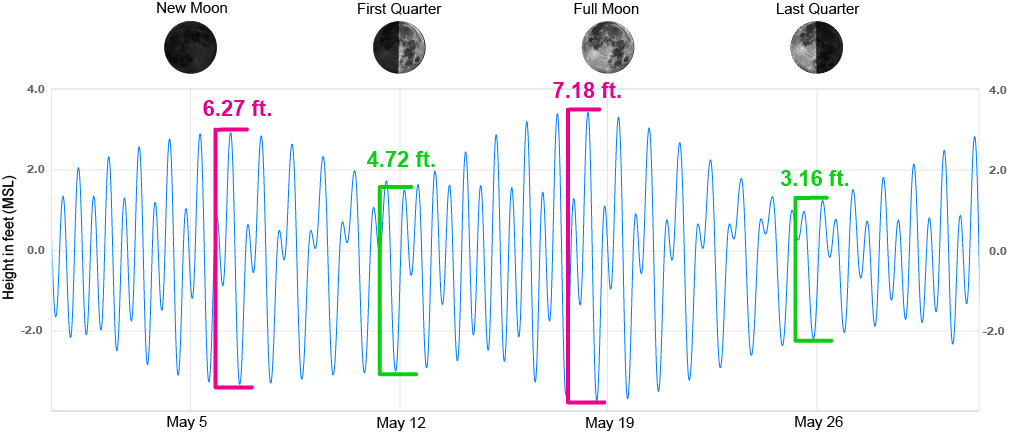Tides are another type of wave motion – a change in the ocean water level that typically reaches a high and low twice a day, about six hours apart (called a semi-diurnal tide). The change from low to high tide is called the "flood tide" or “flow”. The change from high to low tide is called the "ebb tide".
Tides result from the pull of gravity from the Earth alone, between the Earth and the Moon, and between the Earth and the Sun. Because of the larger mass of the Sun, its gravitational pull on the Earth is about 178 times stronger than the Moon’s gravitational pull on the Earth. However, because of the Moon’s much closer proximity, the Moon’s tidal pull on the Earth is over twice that of the Sun’s.
The result of this tidal pull is a bulge in the ocean water on either side of the Earth, almost in line with the position of the Moon. As the Earth makes each 24-hour rotation, we pass under these areas where the tidal force acts on the water. When we observe the tides, we are actually seeing the result of the Earth rotating under this bulge.
If this pull creates a bulge of water on the side of the Earth facing the Moon, then why is there also a bulge on the opposite side, away from the Moon?
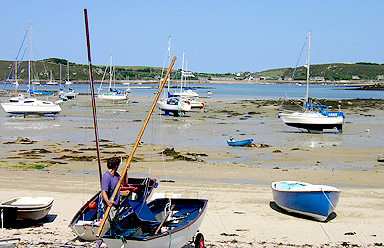
The key to understanding this is to recognize that gravitational forces are not only pulling the oceans closer to the Moon but are actually pulling the entire Earth itself. Ocean tides are simply the most visible indication of this pull.
As the distance between two objects decreases, the pull of gravity becomes stronger. This means there is an uneven pull between the side of the Earth closest to the Moon, the side farthest away, and all points in between. In other words, gravity pulls a little harder on the part of the Earth closest to the Moon (point "C” in Fig. 1 below) than it does at the center of the Earth (point "O"), while the pull is weakest at the point farthest from the Moon (point "F"). As a result, the planet is slightly stretched towards the Moon, with water on the far side essentially lagging behind and creating the second bulge.
If not for the Earth's own gravity pulling its own mass together, the planet itself would be stretched and pulled apart.
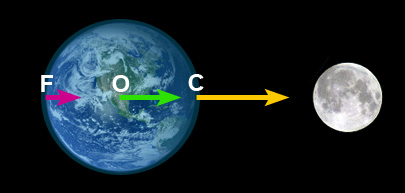
We can describe this mathematically using vectors. If we subtract the force of the Moon's mid-range pull at the center of the Earth from both the stronger pull at point "C" and weaker pull at "F”, we are left with two smaller forces: one directed toward the moon and one away from the moon (Fig. 2), describing the two bulges.
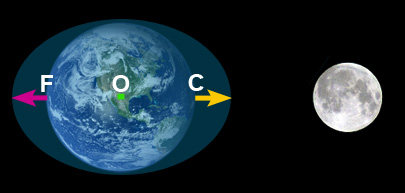
Since the difference in gravitational force is constant across the Earth, the bulge on both sides of the Earth is essentially the same. Therefore, consecutive high tides are nearly the same height each time, regardless of whether the Moon is overhead or on the opposite side of the Earth.
However, the actual change in daily tide level is affected by many additional factors that depend on location. The oceans and shorelines have complex shapes, and the depth and configuration of the sea floor varies considerably, all influencing the flow and movement of water. As a result, some locations only experience one high and low tide each day, called a diurnal tide. Other sites have mixed tides, in which successive high-water and low-water marks differ appreciably.
Take it to the MAX! The Fun Bay of Fundy
The shape and orientation of the orbits of the Moon and the Earth also affect the tides. Both orbits are not circles but ellipses, and as a result, the distance between the Earth and Moon can vary by up to 13,000 miles (31,000 km) over its 28-day orbit. Since tidal force increases with decreasing distance, tides are higher when the Moon is at its closest point to the Earth (called perigee) and lower at its farthest point (called apogee). Likewise, the Earth's elliptical orbit around the Sun results in variations in the Sun's pull over the course of a year. Additionally, the Moon's orbit is inclined 5° relative to the Earth's rotation. Therefore, the north/south orientations of the bulge vary across the Northern and Southern Hemispheres during the 28-day orbital period.
As the Moon completes one orbit around the Earth, the Earth, Moon, and Sun twice form a line and twice form a right angle.
When all three are in line (around full and new moons), the combined tidal effect of the Moon and Sun is at its greatest, resulting in the largest difference between high and low tide. This is called a "spring" tide (from the water springing or rising up).
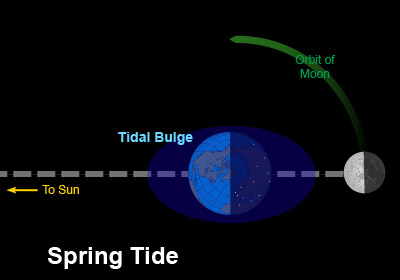
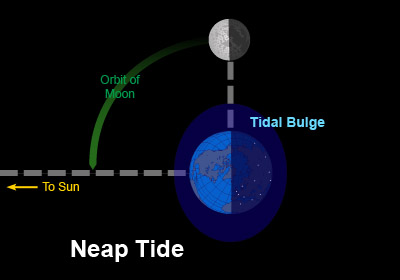
Seven days after either a full or new moon, the Earth, Moon, and Sun form a right angle, and the pull of the Moon and Sun partially cancel each other out. The resulting tide, called a "neap" tide, has the smallest difference between high and low tide.
